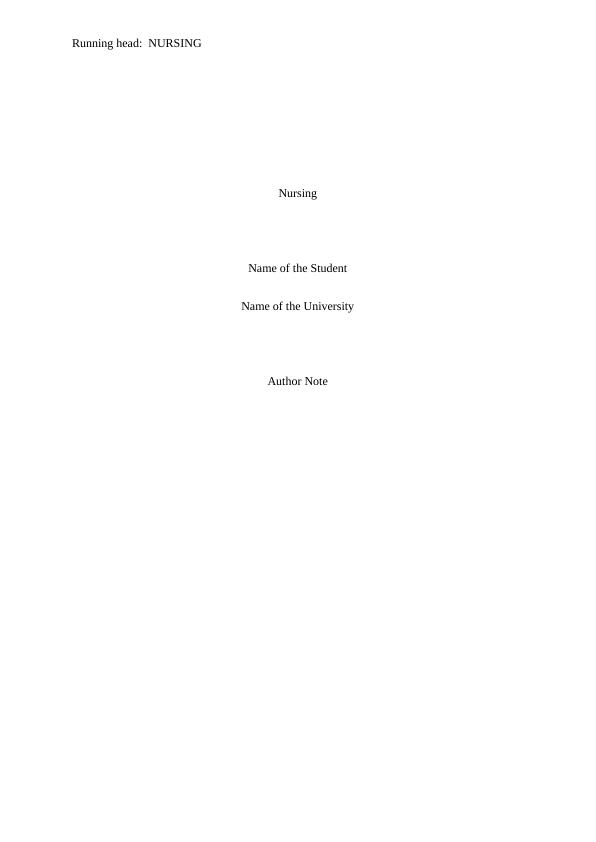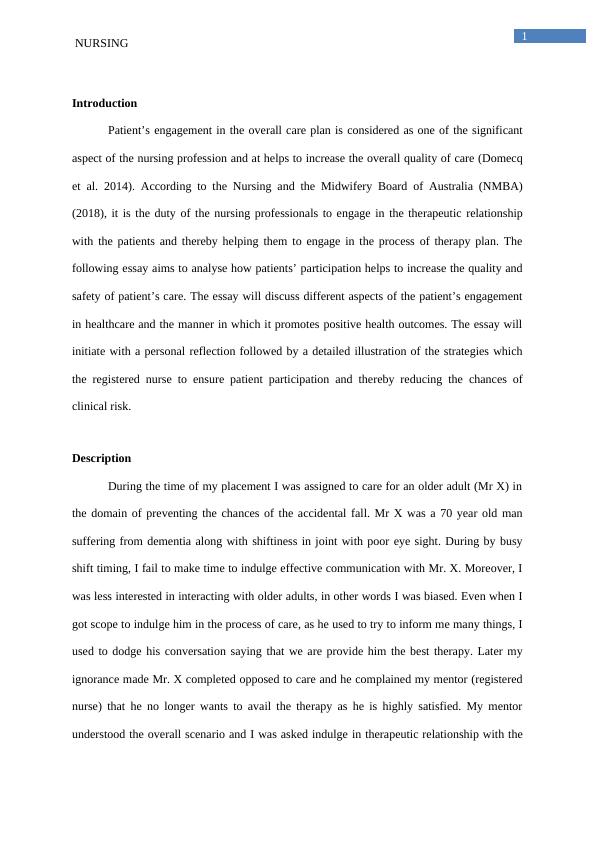Strategies to Promote Patient Engagement and Reduce Clinical Risk
Added on 2023-04-19
10 Pages2573 Words348 Views
Running head: NURSING
Nursing
Name of the Student
Name of the University
Author Note
Nursing
Name of the Student
Name of the University
Author Note

1
NURSING
Introduction
Patient’s engagement in the overall care plan is considered as one of the significant
aspect of the nursing profession and at helps to increase the overall quality of care (Domecq
et al. 2014). According to the Nursing and the Midwifery Board of Australia (NMBA)
(2018), it is the duty of the nursing professionals to engage in the therapeutic relationship
with the patients and thereby helping them to engage in the process of therapy plan. The
following essay aims to analyse how patients’ participation helps to increase the quality and
safety of patient’s care. The essay will discuss different aspects of the patient’s engagement
in healthcare and the manner in which it promotes positive health outcomes. The essay will
initiate with a personal reflection followed by a detailed illustration of the strategies which
the registered nurse to ensure patient participation and thereby reducing the chances of
clinical risk.
Description
During the time of my placement I was assigned to care for an older adult (Mr X) in
the domain of preventing the chances of the accidental fall. Mr X was a 70 year old man
suffering from dementia along with shiftiness in joint with poor eye sight. During by busy
shift timing, I fail to make time to indulge effective communication with Mr. X. Moreover, I
was less interested in interacting with older adults, in other words I was biased. Even when I
got scope to indulge him in the process of care, as he used to try to inform me many things, I
used to dodge his conversation saying that we are provide him the best therapy. Later my
ignorance made Mr. X completed opposed to care and he complained my mentor (registered
nurse) that he no longer wants to avail the therapy as he is highly satisfied. My mentor
understood the overall scenario and I was asked indulge in therapeutic relationship with the
NURSING
Introduction
Patient’s engagement in the overall care plan is considered as one of the significant
aspect of the nursing profession and at helps to increase the overall quality of care (Domecq
et al. 2014). According to the Nursing and the Midwifery Board of Australia (NMBA)
(2018), it is the duty of the nursing professionals to engage in the therapeutic relationship
with the patients and thereby helping them to engage in the process of therapy plan. The
following essay aims to analyse how patients’ participation helps to increase the quality and
safety of patient’s care. The essay will discuss different aspects of the patient’s engagement
in healthcare and the manner in which it promotes positive health outcomes. The essay will
initiate with a personal reflection followed by a detailed illustration of the strategies which
the registered nurse to ensure patient participation and thereby reducing the chances of
clinical risk.
Description
During the time of my placement I was assigned to care for an older adult (Mr X) in
the domain of preventing the chances of the accidental fall. Mr X was a 70 year old man
suffering from dementia along with shiftiness in joint with poor eye sight. During by busy
shift timing, I fail to make time to indulge effective communication with Mr. X. Moreover, I
was less interested in interacting with older adults, in other words I was biased. Even when I
got scope to indulge him in the process of care, as he used to try to inform me many things, I
used to dodge his conversation saying that we are provide him the best therapy. Later my
ignorance made Mr. X completed opposed to care and he complained my mentor (registered
nurse) that he no longer wants to avail the therapy as he is highly satisfied. My mentor
understood the overall scenario and I was asked indulge in therapeutic relationship with the

2
NURSING
patients in order to deliver patient centred care. Eventually, Mr. X become cooperative and
his level of satisfaction in receiving the therapy increased.
Feelings
Initially the incident made me quite upset. I felt sorry for by biased attitude and my
inability to indulge in therapeutic relationship with client and procurement of patient centred
care. I went to my mentor (nurse leader or the registered nurse) in order to discuss about my
gap in practice. I was shattered and was suffering from lack of confidence and was unable to
concentrate on the task. My mentor explained me that my gap in communication with the
patient created barrier in the patient engagement and thereby decreasing the level of patient
satisfaction in the care process. I understood my fault and gradually tried to overcome my
bias and also felt the need to work on my interpersonal communication skills.
Evaluation
The negative part of the incident was patient’s sudden withdrawal from the therapy.
On evaluating my performance, the nurse leader guided me and helped to work on my inter-
personal communication skills. She also made me realize that every patient is same for the
nurses and we cannot have a biased or ignorant attitude just because the patient is an older
adult. She also highlighted that not engaging him in the therapy plan or not listening to his
concerns made him feel humiliated and thus decreased his satisfaction. I felt sorry about the
overall behaviour.
Analysis
Under this context it can be said that the nursing professional holds a significant part
in the process of the patient engagement and highlighting the exact needs of the patient.
Effective communication with the patient, and actively listening to their concerns, help to
NURSING
patients in order to deliver patient centred care. Eventually, Mr. X become cooperative and
his level of satisfaction in receiving the therapy increased.
Feelings
Initially the incident made me quite upset. I felt sorry for by biased attitude and my
inability to indulge in therapeutic relationship with client and procurement of patient centred
care. I went to my mentor (nurse leader or the registered nurse) in order to discuss about my
gap in practice. I was shattered and was suffering from lack of confidence and was unable to
concentrate on the task. My mentor explained me that my gap in communication with the
patient created barrier in the patient engagement and thereby decreasing the level of patient
satisfaction in the care process. I understood my fault and gradually tried to overcome my
bias and also felt the need to work on my interpersonal communication skills.
Evaluation
The negative part of the incident was patient’s sudden withdrawal from the therapy.
On evaluating my performance, the nurse leader guided me and helped to work on my inter-
personal communication skills. She also made me realize that every patient is same for the
nurses and we cannot have a biased or ignorant attitude just because the patient is an older
adult. She also highlighted that not engaging him in the therapy plan or not listening to his
concerns made him feel humiliated and thus decreased his satisfaction. I felt sorry about the
overall behaviour.
Analysis
Under this context it can be said that the nursing professional holds a significant part
in the process of the patient engagement and highlighting the exact needs of the patient.
Effective communication with the patient, and actively listening to their concerns, help to

End of preview
Want to access all the pages? Upload your documents or become a member.
Related Documents
Fishbone Diagram Analysis for Improving Patient Care in Nursinglg...
|9
|1924
|447
Patient-Centred Care and Fall Prevention Strategies for Older Adults: A Case Studylg...
|7
|2078
|407
Episode of Care for a Patient with Parkinson's Disease and Vascular Dementialg...
|14
|4943
|459
Culture and Health | Assignmentlg...
|5
|1210
|179
Nursing Reflective Essaylg...
|6
|1400
|366
Reflective Practice in Nursing: Ethical Issues and Effective Nursinglg...
|5
|1473
|35
